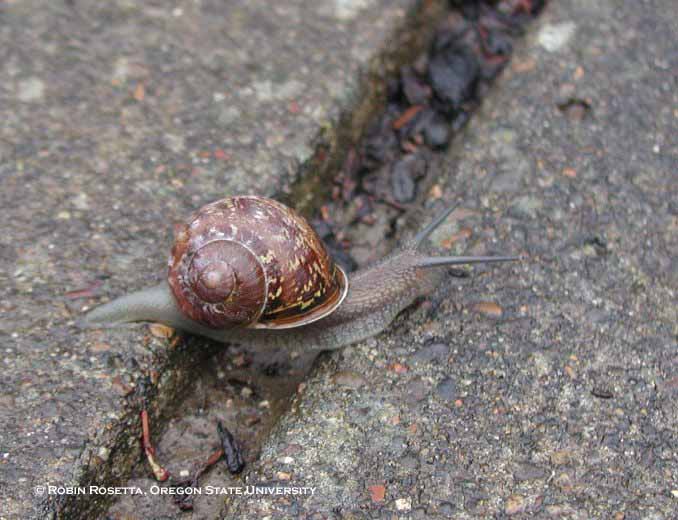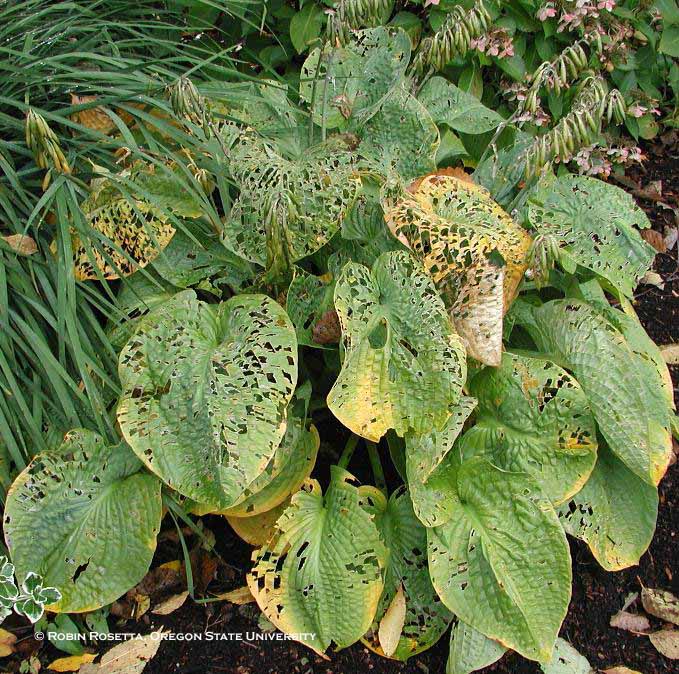Brown garden snail, Cornu aspersa (formerly Helix aspersa, Cantareus aspersus, and Cryptomphalus aspersus) is a member of the family Helicidae. This snail species originates from Britain, western Europe, and along borders of the Mediterranean and Black Seas. There have been introductions of this species into Argentina, the Atlantic Islands, Australia, Chile, Haiti, Mexico, New Zealand, and South Africa. In the United States, it is reported from California north to British Columbia, Canada, in most southeastern states and along the east coast north to New Jersey. This snail is reported to cost the state of California 7-10 million dollars every year.
Currently brown garden snail presents the greatest risk to nurseries given its status as a quarantine pest and its establishment in sites around Oregon and Washington. The brown garden snail feeds on a wide range of host material and can commonly be found climbing into trees and shrubs. Closely related snails of concern are the European apple snail, H. pomatia, and the green snail, H. aperta.
Management of brown garden snail in nurseries generally requires a focus on prevention, primarily with inspection of incoming plant material and quarantine. If detected in a nursery, this species must be eradicated and chemical control is the most common tool for this purpose. Choices include carbamate molluscicides such as methiocarb (Mesurol), a restricted use product, and metaldehyde sprays or baits (several brands). An alternative to carbamate products are baits containing iron phosphate (Sluggo). The active ingredient is naturally occurring and OMRI approved. It must be ingested for activity, which includes damage to the snail's crop and hepatopancreas. This causes the snails to stop feeding and eventually to die by starvation. Treated snails tend to wonder away so treatment evaluation should be based on reduction of feeding damage. Dazitol is another alternative chemical option for nurseries. It is a combination product with the active ingredients: capsaisin and allyl isothiocyanate, an essential oil from mustard plants. Recent trials with another snail species, amber snails, here in Oregon showed good efficacy.
Landscape options include metaldehyde baits (several brands). Caution should be used with these baits as they can be toxic if ingested by pets. Alternative chemical options include: iron phosphate baits (several brands), some botanical products such as limonene (Orange Guard), and repellent botantical products such as cinnamon oil (Slug and Snail Away).
Cultural control:
Barriers such as copper strips are effective although expensive. Hand picking and disposal of the snails can reduce populations as well. Reduce habitat by eliminating weeds and clean up debris under which they can hide. Snail traps, both commercial and homemade, often use a beer-based attractant to lure snails inside to drown.
Biological Control:
The biological control agent, decollate snail, Rumina decollata, is considered a threat to native slug and snail species as well as a direct plant feeder and banned from shipment to the Pacific Northwest. Similarly beneficial nematode, Phasmarhabdis sp., a biological control agent used in Europe, is not registered for use in the US and prohibited. Naturally occurring enemies of snails include ground beetles, parasitic flies, and predators such as frogs, lizards, and birds. Many people utilize chickens or geese to manage snails and slugs.
There are some useful sites to gather more information on this snail species:
The Living World of Molluscs: The Brown Garden Snail
Canada Food Inspection Agency: Helix aspersa (Muller) - European brown garden snail.
M. L. Flint and C. A. Wilen. Pests in Gardens and Landscapes: Snails and Slugs. UC IPM Online.
Original publication: 12/10/2007
Most recent update. 1/24/2011
Author: R.L. Rosetta, Extension Nursery Integrated Pest Management, Department of Horticulture, Oregon State University
Page last modified 4/19/16
Brown Garden Snail
Young brown garden snail
Brown garden snail damage on Hosta
Brown garden snail damage to Hosta




